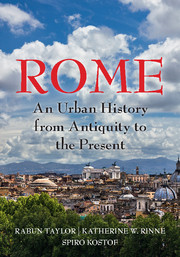Book contents
- Frontmatter
- Dedication
- Epigraph
- Contents
- List of Illustrations
- Acknowledgments
- Map
- INTRODUCTION
- 1 A BEND IN THE RIVER
- 2 A STORYBOOK BEGINNING
- 3 IDEOLOGICAL CROSSFIRE
- 4 BIG MEN ON THE CAMPUS
- 5 RES PUBLICA RESTITUTA
- 6 MEMORIALS IN MOTION: SPECTACLE IN THE CITY
- 7 THE CONCRETE STYLE
- 8 REMAKING ROME'S PUBLIC CORE: I
- 9 REMAKING ROME'S PUBLIC CORE: II
- 10 CRISIS AND CONTINUITY
- 11 RUS IN URBE: A GARDEN CITY
- 12 ADMINISTRATION, INFRASTRUCTURE, AND DISPOSAL OF THE DEAD
- 13 MAPPING, ZONING, AND SEQUESTRATION
- 14 TETRARCHIC AND CONSTANTINIAN ROME
- 15 TROPHIES AND TITULI: CHRISTIAN INFRASTRUCTURE BEFORE CONSTANTINE
- 16 WALLS MAKE CHRISTIANS: FROM FOURTH TO FIFTH CENTURY
- 17 A TALE OF TWO ROMES
- 18 THE ROME OF GOTHS AND BYZANTINES
- 19 CHRISTIAN FOUNDATIONS
- 20 FROM DOMUS LATERANI TO ROMANUM PALATIUM
- 21 THE LEONINE CITY: ST. PETER'S AND THE BORGO
- 22 VIA PAPALIS, THE CHRISTIAN DECUMANUS
- 23 THE URBAN THEATERS OF IMPERIUM AND SPQR
- 24 HOUSING DAILY LIFE
- 25 CHAOS IN THE FORTIFIED CITY
- 26 THE TIBER RIVER
- 27 HUMANIST ROME, ABSOLUTIST ROME (1420–1527)
- 28 PLANNING COUNTER REFORMATION ROME
- 29 PROCESSIONS AND POPULATIONS
- 30 MAGNIFICENT PALACES AND RHETORICAL CHURCHES
- 31 NEOCLASSICAL ROME
- 32 PICTURING ROME
- 33 REVOLUTION AND RISORGIMENTO
- 34 ITALIAN NATIONALISM AND ROMANITÀ
- 35 A CITY TURNED INSIDE OUT
- Glossary of Persons, Places, and Terms
- Works Cited
- Index
28 - PLANNING COUNTER REFORMATION ROME
Published online by Cambridge University Press: 05 July 2016
- Frontmatter
- Dedication
- Epigraph
- Contents
- List of Illustrations
- Acknowledgments
- Map
- INTRODUCTION
- 1 A BEND IN THE RIVER
- 2 A STORYBOOK BEGINNING
- 3 IDEOLOGICAL CROSSFIRE
- 4 BIG MEN ON THE CAMPUS
- 5 RES PUBLICA RESTITUTA
- 6 MEMORIALS IN MOTION: SPECTACLE IN THE CITY
- 7 THE CONCRETE STYLE
- 8 REMAKING ROME'S PUBLIC CORE: I
- 9 REMAKING ROME'S PUBLIC CORE: II
- 10 CRISIS AND CONTINUITY
- 11 RUS IN URBE: A GARDEN CITY
- 12 ADMINISTRATION, INFRASTRUCTURE, AND DISPOSAL OF THE DEAD
- 13 MAPPING, ZONING, AND SEQUESTRATION
- 14 TETRARCHIC AND CONSTANTINIAN ROME
- 15 TROPHIES AND TITULI: CHRISTIAN INFRASTRUCTURE BEFORE CONSTANTINE
- 16 WALLS MAKE CHRISTIANS: FROM FOURTH TO FIFTH CENTURY
- 17 A TALE OF TWO ROMES
- 18 THE ROME OF GOTHS AND BYZANTINES
- 19 CHRISTIAN FOUNDATIONS
- 20 FROM DOMUS LATERANI TO ROMANUM PALATIUM
- 21 THE LEONINE CITY: ST. PETER'S AND THE BORGO
- 22 VIA PAPALIS, THE CHRISTIAN DECUMANUS
- 23 THE URBAN THEATERS OF IMPERIUM AND SPQR
- 24 HOUSING DAILY LIFE
- 25 CHAOS IN THE FORTIFIED CITY
- 26 THE TIBER RIVER
- 27 HUMANIST ROME, ABSOLUTIST ROME (1420–1527)
- 28 PLANNING COUNTER REFORMATION ROME
- 29 PROCESSIONS AND POPULATIONS
- 30 MAGNIFICENT PALACES AND RHETORICAL CHURCHES
- 31 NEOCLASSICAL ROME
- 32 PICTURING ROME
- 33 REVOLUTION AND RISORGIMENTO
- 34 ITALIAN NATIONALISM AND ROMANITÀ
- 35 A CITY TURNED INSIDE OUT
- Glossary of Persons, Places, and Terms
- Works Cited
- Index
Summary
EARLY-SIXTEENTH-CENTURY PROTESTANT REFORMERS VIEWED THE CATHOLIC Church as a morally depraved body in which popes operated like kings, cardinals lived like princes, and monks were dissolute fornicators. In response to allegations of corruption, Paul III convened the Council of Trent (1545–1563), an assembly of bishops and theologians, to clarify Church doctrine. The council met for 25 extended sessions over the next 18 years. Pius IV de’ Medici (1559–1565) ratified its decrees in January 1564, ushering in the period known as the Counter Reformation, and promulgated strict rules to reaffirm the primacy and legitimacy of Catholicism.
Because Rome, the head of the Church, was also in disarray, Pius and his immediate successors set about restoring its buildings and streets. The cleansed and renewed city would mirror the new moral order of the Church and its clergy. Over the next half-century they initiated grand urban infrastructure projects: restoring ancient aqueducts; regularizing, widening, and paving streets and piazzas; cutting new straight avenues through the medieval maze; building new drains and sewers; and legislating the disposal of rubbish.
Restoring the Aqua Virgo, now called the Acqua Vergine, was the first priority. It had supplied the Campo Marzio modestly throughout the medieval period and Nicholas V had partially restored it in the 1450s, but still its delivery was sporadic and inadequate. By 1570, Pius V Ghisleri (1566–1572) had restored it back to its abundant and pure source springs. With an assured water supply, he proposed 17 new public fountains in important locations including Piazza Colonna, Piazza Navona, Piazza del Popolo, and Piazza della Rotonda. This hydraulic scheme, on a scale not seen in Rome since antiquity, provided drinking water for people and animals; in some cases, it also spurred urban development (Fig. 170).
Streets were torn up to accommodate the distribution conduits and new drains to carry off any water that could not be reused, such as that from laundries and wool factories. When possible, the drains were linked to newly discovered and restored ancient drains and sewers. The whole project provided a perfect opportunity to improve living conditions in the Campo Marzio – with the added bonus of newly paved streets once the work was completed.
- Type
- Chapter
- Information
- RomeAn Urban History from Antiquity to the Present, pp. 261 - 270Publisher: Cambridge University PressPrint publication year: 2016



